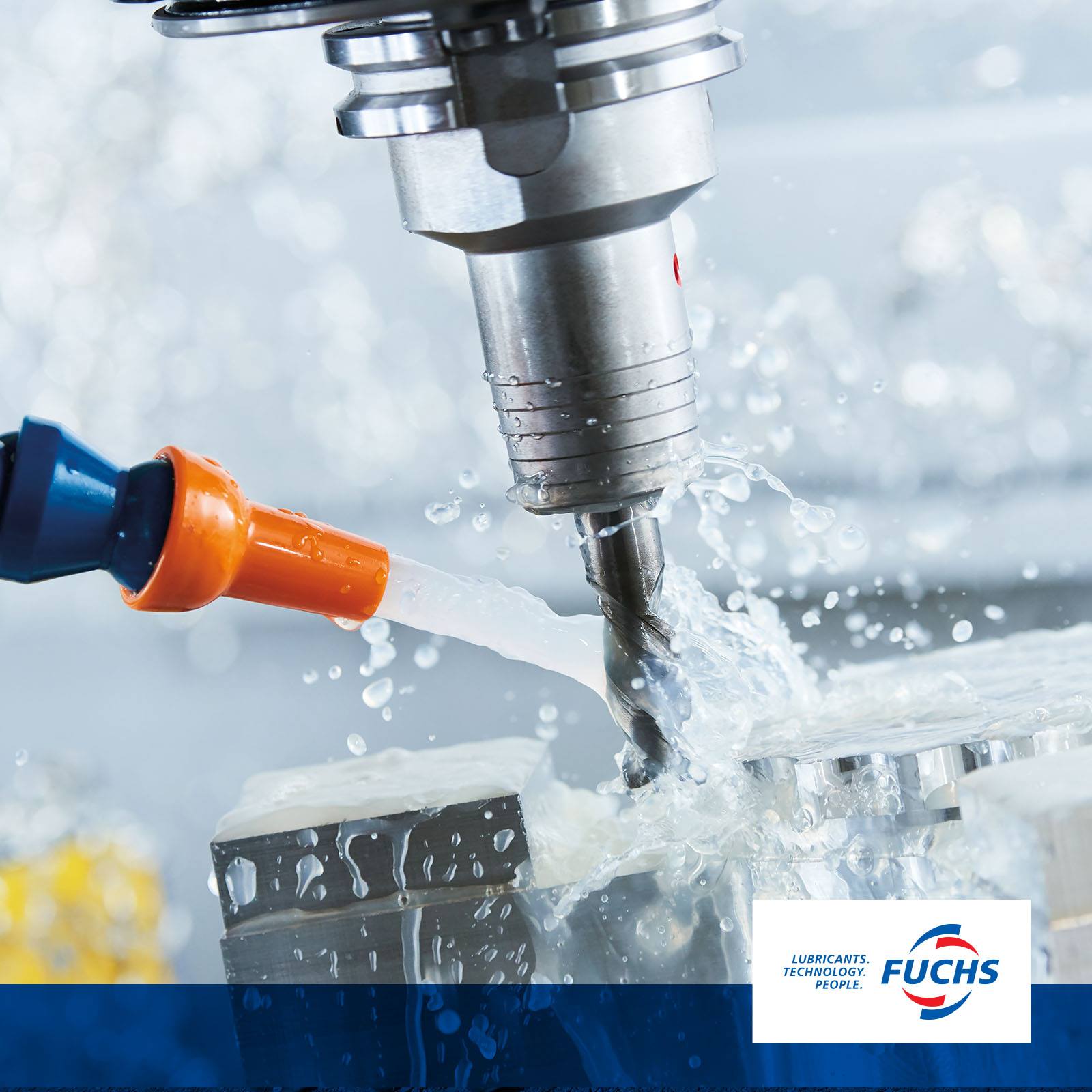MAINTAINING CUTTING FLUIDS
Machining fluids contain a complex mixture of several potentially hazardous chemicals. The Safety Data Sheet (SDS) details risks associated with machining fluids, but it is important to remember that these risks are identified for the fluid concentrate. Many of these risks are greatly minimised when the fluids are diluted with water for use and properly maintained. Most regulations require exposure to metalworking fluids to be adequately controlled and reduced to a minimum with all non-essential exposure minimised.
The service life of water-miscible cutting fluids can be decisively influenced by the thorough cleaning and disinfection of the cutting fluid system. Acceptably good service life can only be achieved if systems are properly cleaned and disinfected prior to initial filling.
The following procedure has proven to be successful in the maintenance of cutting fluid:
1. Add system cleaner to the cutting fluid prior to draining
System cleaners are used to clean and disinfect difficult-to-reach and inaccessible parts of the cutting fluid system. In these products, special agents ensure that such areas are wetted. They dislodge deposits, fungal infestations and bacterial colonies. The built in emulsifiers dissipate floating creamy oil and transport impurities in the system. The microbiocides in system cleaners serve to “disinfect” the whole system.
When using system cleaners, it is important to use the correct concentration and to observe the recommended application time. Always follow the recommendations of the cleaner’s manufacturer.
The following procedure has proven to be successful:
- Add system cleaner to the cutting fluid prior to draining
- Allow to circulate for 8 to 24 hours
- Drain the tank
- Mechanical cleaning of the tank, conveyor, etc.
- Flush cutting fluid system with fresh emulsion
- Refill cutting fluid system
The fungi problem should be mentioned here. These are sometimes still in fluids after treatment with system cleaners. One problem could be fungicidal films which are not fully dislodged by system cleaners and whose fungi spores can re-infect fresh cutting fluid batches. In such cases, it is recommended that in consultation with the cutting fluid supplier, the fresh fluid is subjected to further repeated treatment with fungicides.
2. Preservatives for water-miscible cutting tools
Water-miscible cutting fluids mainly consist of nitrogen, carbon, oxygen as well as sulphur and phosphorous compounds which are a nutritional basis of biological growth. Excessive bacterial counts can permanently impair cutting fluids, reduce their life and thus harm the environment. Bactericides (substances which destroy bacteria) and fungicides (substances which destroy fungi) are used to conserve water-miscible cutting fluids.
Without such conservation, bacterial and fungal growth would soon render cutting fluids unusable, which would endanger not just the environment but also the health of workshop personnel who work with cutting fluids. Further information on this can be found in the VDI Guideline 3397, Part 4 and BGI / GUV–I 762.
Bactericides: Combat bacterial attack
Fungicides: Combat fungal growth
The EU Biocide guidelines (BPR, Guideline (EU) No. 528/2012) have serious consequences on the availa- bility of biocides for cutting fluids. All biocides for the Product Group 13 (cutting fluids) must be thoroughly tested for their danger to people and the environment. Many biocide manufacturers have been scared off because of these cost-intensive tests. As of March 2017, only 25 substances (from over 1,000) remain available, including 13 formaldehyde-splitters (FAD), some of the most important bactericides for cutting fluids. The controversial classifi- cation of fomaldehyde (not to be confused with FAD) in “Carcinogenic Catergory 1B”, has also led to critism of formaldehyde-releasing agents.
3. Defoamers
The use of defoamers is only recommended if the cause of the foaming is either unknown or is known but cannot be eliminated in the short-term, for example, if water quality fluctuates, contaminants are dragged in through alterations in machining sequences, cutting fluids changes, etc. Defoamers should only be added if good mixing can be guaranteed.
Defoamers should only be added if good mixing can be guaranteed. Additions up-stream from filters should be avoided because they may be filtered-out. The supplier’s recommended usage concentration must be observed. Excessive doses of defoamers can detrimen- tally affect air release properties and the foam may even become more stable. Before adding defoamers to cutting fluids, they should first be diluted with water. This allows the optimum effect to be generated because the defoamer mixes more rapidly.
4. Other service products
This category includes all special products whose use is beneficial to users and which can be used in line with cutting fluid manufacturer’s recommendations, such as products to boost cutting performance, increase pH value or improving corrosion protection.
5 Preventative measures
To reduce the cost and complexity of cutting fluid maintenance, preemptive measures can be taken in advance, for example, when new machines are ordered.
These are usually simple, mechanical solutions which generate very little or no extra costs but which can significantly reduce the time and effort necessary for monitoring when machine tools are in use.
a) Type of cutting fluid First of all, there should be clarity regarding the type of cutting fluid to be used. This does not mean that operators have to know whether their cutting fluid will be manufactured by company A or B, but whether a water- miscible or neat cutting fluid will be used. This decision alone can cut subsequent monitoring and maintenance costs.
b) Location of the cutting fluid tank When operators order machines, attention should be paid to whether cutting fluid supply and return tanks and and anciliary machinery are easily accessible for later maintenance and cleaning measures.
c) Size of the cutting fluid circulation system A sufficiently large cutting fluid circulation tank volume is a decisive criterium for the later, foam-free operation of machine tools. We advise consulting and following the recommendations in VDI Guideline 3035.
d) Resting zones in cutting fluid tanks If water-miscible cutting fluid maintenance equipment is used, it may be worthwhile constructing so-called resing zones inside the various tanks so that any tramp oils can rise up and be removed.
e) Interior walls of the cutting fluid tank Interior surfaces of tanks should not be painted, galvanized or coated in any other way as such coatings may be attacked and become detached which, in turn, can cause filter problems. Find a water-miscible cutting fluid for the metal processing industry here: https://bit.ly/3ke0m6G


